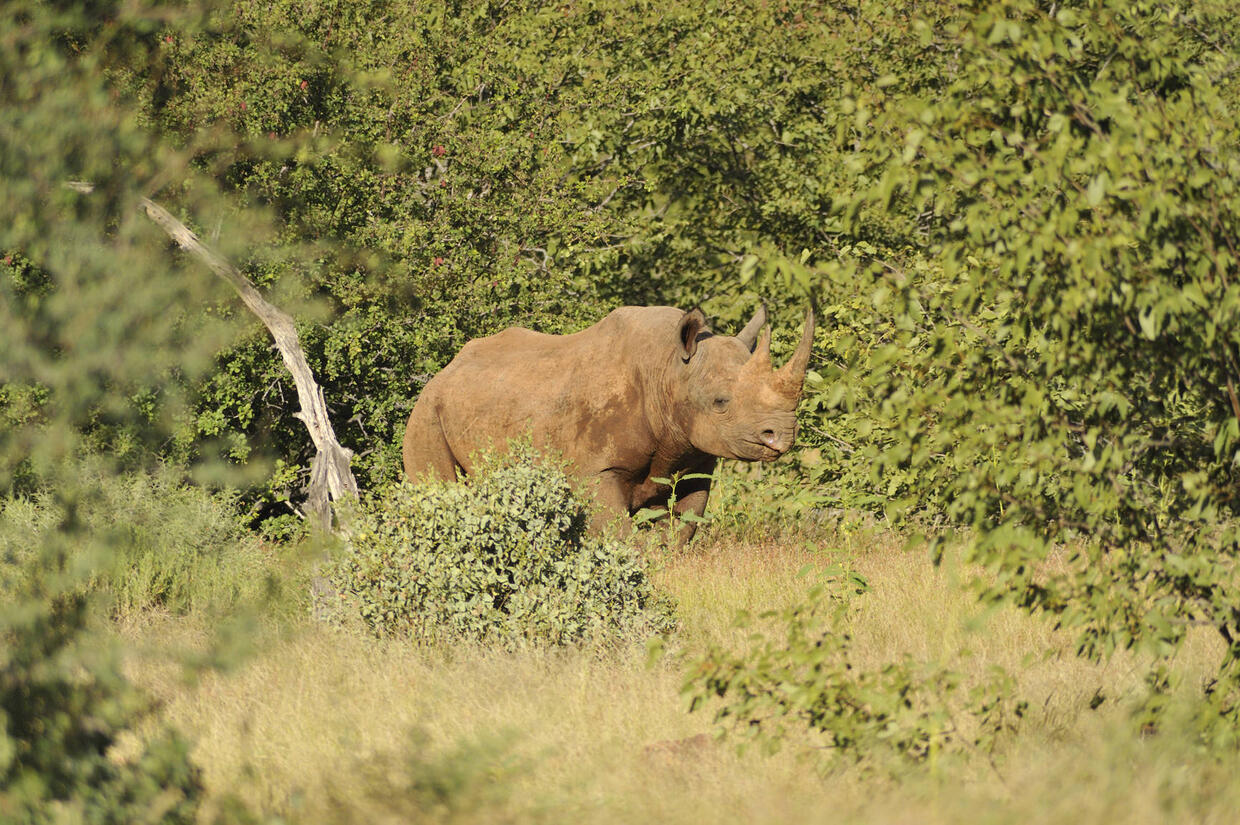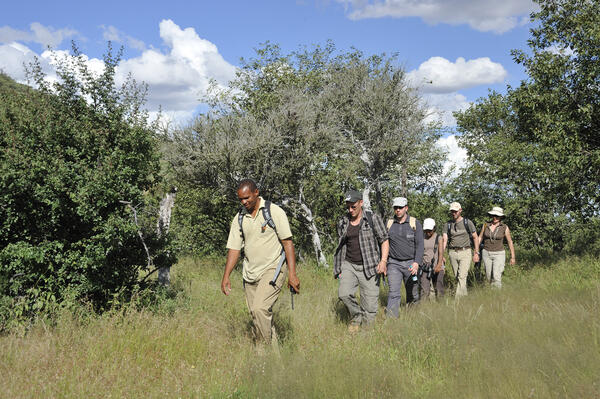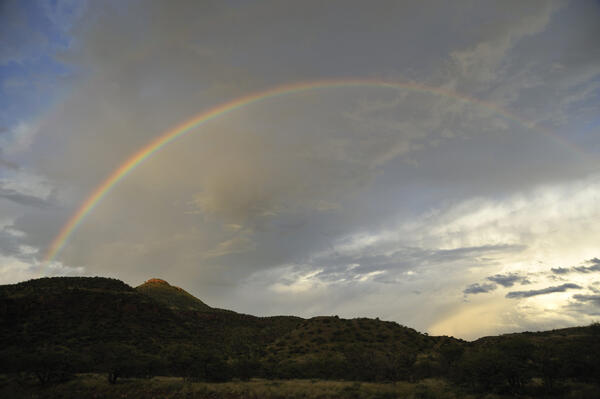
On a wind chilled April morning, high on the Grootberg Plateau, Wilhelm Christian greets the Dabenoc family from France. Florence and Guillaume are on holiday, and as Guillaume means William in French, the ice is soon broken with Wilhelm, the tour guide. Together with trackers Lazarus and Naftali, the group is setting off to look for black rhino in the Klip river valley.
We could be in Scotland instead of Namibia. Clouds cling to the top of the mountains as the Land Rover lurches across boulders and through the first river bed. All the water courses are running. But this is ≠Khoadi-//Hoâs Conservancy, 350,000 hectares of land run by the local community that also owns Grootberg Lodge on the Khorixas-Kamanjab road. The Conservancy employs guides and trackers, and pays for their training, either at Wilderness Safaris or the Save the Rhino Trust. It is a professional commercial organisation, making money from tourists to benefit the rural community, and protecting wildlife into the bargain.
We spot some kudus and the family of six start snapping while Wilhelm gives an expert talk about horns. Kudus get their first horn twist at 2 years and another every year. The horns stop growing after 4 or 5 years. Further down the sun dappled valley there is a flurry of bright green flashes by the river bank. “Rosy faced love birds,” says Wilhelm, who knows every animal and bird species in the area.
Spotting wildlife in conservancies seems more exciting than in National Parks, where they are more concentrated. That’s more true of black rhino than other species. Before the white man brought guns to Africa, there were half a million black rhinos on the continent. By 1980 there were only an estimated 80 left in north-west Namibia, through which the Klip river valley runs. Large scale killing for ‘sport’, followed by poaching, had brought the black rhino to the verge of extinction.
The tragedy has been followed by a modest triumph. Game guards were introduced to the area by the Namibian Wildlife Trust and later by Integrated Rural Development and Nature Conservation, working through communal conservancies that were established after far sighted government legislation in 1994 allowed rural people to have control over the wildlife resources in their areas.
Wilhelm, Lazarus and Naftali all served their time as game guards, known as environmental shepherds because they spent a lot of their time assisting small stock farmers with vaccination programmes and water points, the latter being useful for elephants as well as cattle and goats. Poaching was all but eliminated in the area, and as a result, the Ministry of Environment and Tourism had the confidence to translocate black rhino and other species out of the national parks, back into conservancy areas.
The Klip river valley now has 7 rhinos, all black. As Lazarus and Naftali leap off the open Land Rover and dart off across the thick grass looking for tracks, Wilhelm introduces the differences between black and white rhinos with a joke. Black women carry their babies on their backs, he says, while white women carry them in front. If you see a rhino with a calf trotting in front, it’s sure to be a white rhino. The black rhino calf follows the mother. Black rhinos are smaller; the adults are between 1,200 and 1,600 kilos (quite cute really), and the black rhino browses on bushes instead of eating grass, which is why it evolved a pointed mouth rather than the square jaw of the white rhino.
The tracks we find are old, which is a problem. It is already 11 o’clock and the sun is getting hot. That’s the time that many tourists start to think about lunch and getting back to the lodge. Not the Dabenoc family – they are prepared to stay out all day. Finding rhino used to be easy. When they were translocated the Ministry inserted transmitters into their horns to make them easier to find and protect from poachers. But the transmitters have stopped working, and anyway the calves don’t have them. Now finding rhino is done in the area by following tracks from where the rhinos last were, but the valley is vast and full of bushes and small clumps of trees. It’s a needle in a haystack job.
Wilhelm decides to move on to another section of the valley, which is a slow and bumpy ride through flowing streams and up and down steep banks. The last sighting was four rhinos, and he thinks they may have been disturbed and moved on. We reach there at midday and the two trackers speed away from the vehicle scouting the ground. After a while we lose radio contact with them and Wilhelm turns back, hoping to meet them at a pre-arranged rendezvous. In the meantime he spots some old tracks in a muddy spot, and gives a lesson in rhino tracking.
There is some dung on the ground. It is hard to spot at first because black rhino spread out their droppings with their hind feet as they move on, in order to mark their territory. In the dung Wilhelm finds small pieces of bush branches neatly chopped off at a 45 degree angle by the browser’s teeth. Nearby bushes have been broken where the rhino was eating, and there are faint tracks through the grass. But these are clues from two days ago. Today the rhinos are still elusive.
By one in the afternoon it is time to give up, and the tourist group is reconciled to missing their treat. The lunch of sandwiches and cold, bottled water in the shade of a tree is poor compensation. Wilhelm knows it, so he goes off on a solo trek. Half an hour later he is back with a fresh handful of rhino dung in his hand. “Look at this,” he exclaims enthusiastically, pulling the ball apart to reveal the tell-tale bitten off branches. He is back in radio contact with the trackers, who must be exhausted by now. Florence Dabenoc is worried that they will not have drunk water. “No worries,” says Willem. “The valley is full of streams.” He directs the trackers up two hilltops to scan for rhino, and within half an hour there is a sighting.
The outcome is still far from certain. If the rhinos went to one side, they would have a clear 10 kilometre run, and if they fear humans they can run at 45 km an hour! But if they went the other way into a side valley, it will be a dead end. The Dabenoc family is keen, although it is getting late, so we hop across boulders in a river and skirt the mountainside, keeping upwind of the quarry.
Lazarus is ahead of us and suddenly he waves the group to stop. There is a rhino about 500 metres away behind a tree, surrounded by thick bushes. From now on it is a cat and mouse game. The rhino senses the group’s presence and keeps well hidden, moving between the bushes. The group has to climb a steep hillside and move along it, occasionally coming down in the hope of a sighting, and scampering back up when the guide and tracker feel it may be dangerous.
Suddenly Wilhelm waves frantically, urging the group down and close to him. “Can you see it?” he whispers. “There, behind the tree.” Florence Dabenoc is the family photographer and soon has a 400mm lens trained on the rhino. “It’s Elizabeth,” whispers Wilhelm, clearly relieved that he has succeeded in saving the day for the tourists.
A few minutes later the group is following an easier trail back down the side valley, with their pictures safely in their cameras; but there is a bonus: the tracker has found another rhino, named Hans-Otto, and we get a glimpse of him through the trees before Elizabeth decides to go trotting down the valley in plain view before disappearing.
Everybody is happy, including Wilhelm, who has the triple job of finding the rhinos, keeping the tourists safe, and making sure that the rhinos are not stressed. And there’s a fourth job: driving back. It is still a two and a half hour drive back up the valley and we reach the main road well after dark. But who cares? The Dabenocs have seen a black rhino where it should be, in the wild, and the growing rhino population is benefiting the ≠Khoadi-//Hoâs Conservancy by bringing much needed tourist income to the community.



